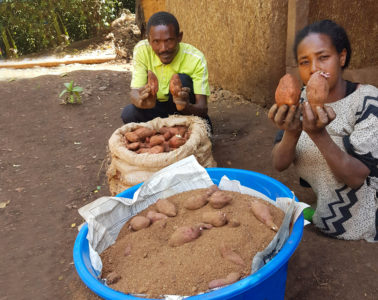
Stopping sweetpotato pathogens
Taking virus detection out of labs
and into farmer fields in Africa
Pests and diseases cost the global agricultural sector an estimated USD 540 billion annually, and in developing countries, they cause potato and sweetpotato farmers to lose up to 60% of their yields.
Viruses can hinder the adoption of orange-fleshed sweetpotato varieties, which the International Potato Center (CIP) promotes as a sustainable source of vitamin A for families in Africa. Spread by whiteflies and aphids, those pathogens also pass from one crop generation to the next in planting material, diminishing the yields of each successive harvest.
As viruses accumulate in plants, and yields decline, farmers may stop growing a nutritious sweetpotato variety, leaving their families at risk of vitamin A deficiency and the many health problems it causes.
Finding ways to manage sweetpotato viruses is thus a priority at CIP, where virologist Jan Kreuze has made recent scientific breakthroughs to develop technologies that could revolutionize disease control in Africa.
Deciphering viruses
Whereas human immune systems create antibodies to destroy viruses, plants have simpler defense responses that chop up a virus’s genetic material—ribonucleic acid (RNA)—when it enters a cell, slowing its ability to cause damage.
Kreuze pioneered the use of genetic sequencing and reassembly of RNA fragments from a plant’s anti-viral response to identify the sweetpotato viruses that infect it. He led a field study that analyzed tissue samples from 1,168 sweetpotato plants in farmer fields across 11 African countries, identifying more than 15 viruses, some previously unknown.
The team then used the data to develop models to predict where specific viruses are likely to be found and how climate change will affect their distribution. They also identified genetic markers to develop a diagnostic field test for three common sweetpotato viruses using a technology known as a LAMP. The LAMP assay is vital because some infected plants are asymptomatic—like many people with COVID-19—which complicates detection.
The LAMP assay, which is faster and cheaper than laboratory-based methods, was tested at four different sites in Kenya and was 100% accurate. Though deployment was delayed by COVID-19, scientists expect the tool to be available soon in Kenya, allowing for the removal of infected planting material from seed systems and faster identification of virus-resistant varieties for farmers.
Diagnosis by phone
With the help of the assay, scientists are using photos of infected plants to develop the artificial intelligence to enable the smartphone app Nuru (“Light” in Swahili) to provide farmers with a real-time diagnosis of sweetpotato virus infections via their phones. Developed by CGIAR and Penn State University scientists, the app is part of a platform called Plant Village that also provides instructions on managing pests and diseases. Nuru has been used since 2018 to diagnose cassava and maize pests and diseases. Sweetpotato is one of a growing number of crops that it will provide diagnoses and advice for.
Both the app and LAMP assay are expected to help identify and control the most common viruses. But more work is needed to understand some previously unknown threats identified by Kreuze’s team. In field trials they discovered that a group of common but asymptomatic viruses, known as begomoviruses, reduced yields of a popular orange-fleshed variety — widely considered virus resistant — by 40%.
“That this variety, which is resistant to the two most common sweetpotato viruses, could suffer that much damage from a third, underlines how much we need to learn,” Kreuze said.
“By better understanding viruses, and improving diagnostic tools, we can help increase crop yields,” he added. “This will put more nutritious food on the tables, and income in the pockets, of some of the world’s most vulnerable families.”
Funders: Bill & Melinda Gates Foundation; Biotechnology and Biological Sciences Research Council; European Union; The Howard G. Buffett Foundation; International Centre for Genetic Engineering and Biotechnology, The World Academy of Sciences and United Nations Educational, Scientific and Cultural Organization; National Science Foundation (US).
Partners: Boyce Thomson Institute; CGIAR Research Program on Roots, Tubers and Bananas; Donald Danforth Plant Science Center; Food and Agriculture Organization of the United Nations; Food and Environment Research Agency/Fera Science Limited; Kenya Plant Health Inspectorate Service and Penn State.
Associated CGIAR Research Programs or Platforms: Roots, Tubers and Bananas.




